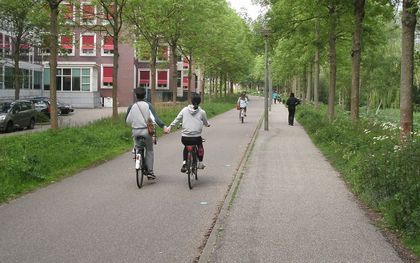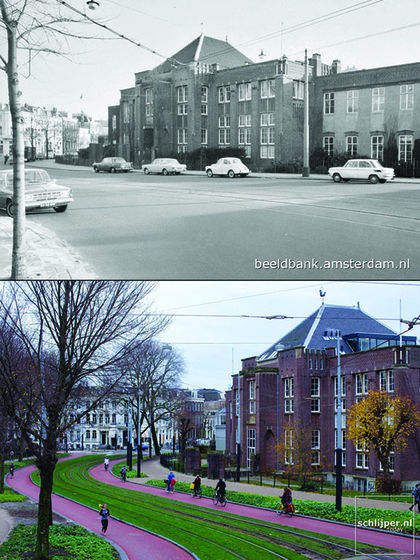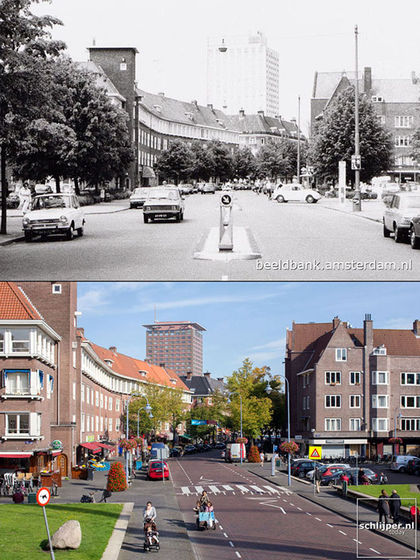Hard News: Fear of Cycling
154 Responses
First ←Older Page 1 2 3 4 5 … 7 Newer→ Last
-
william blake, in reply to
I think if a cyclist is using a shared cycle path, which is prevalent in the West, they have the onus to be able to stop in time for any emergency. Similar to driving a motor vehicle with the 'what if ' principle, it's the heavier, faster vehicles that need to be ready to act. With the greater power comes the greater responsibility.
Sure everybody needs to be aware of latent danger when traversing the city, its best not to test the braking capacity of a 55 tonne truck and daydreaming should be confined to your happy place,not when crossing the road.
It's not that the people lower down the chain are dickheads, it's the fact that we are all dickheads some of the time. We all have to hope that the vehicles around us are travelling a bit more carefully at that moment. We have to look after each other.
-
Stephen R, in reply to
Oddly enough, I’m just back in the door having been reminded that my bete noire is the black BMW.
Black BMWs give me the shits when I'm driving, but on the bike, white taxis are scarier - they tend to take their corners closer to the edge of the road (lower side-ways-G for their passengers?) without regard for whether they're in the cycle lane when they're doing it.
From William Blake:
Many of us are pedestrians, cyclists and motorists at one time or another, why do we adopt intolerant and aggressive positions when we know exactly how and why others are behaving
Speaking for myself, I'm a lot more considerate of cyclists as a driver and a pedestrian since I started biking. Perhaps yet another example of how the general population and I don't share views on certain topics...
-
linger, in reply to
Basically, what you’ve most got to guard against is:
a dick in a box on wheels.
But it’s not easy to predict the contents from the shape of the box,
as shown by the fact that different experiences lead to different predictors. -
"Power commuting cyclists giving a little ping on their bell blasting through pedestrians and animals are just as arrogant as the one tonne metal sledgehammers."
Sheesh, how many cyclists have a bell to give a little ping? When I’m out walking (on a shared track) and cyclists are approaching from behind the answer would appear to be … none. (I have one on my own bike and use it.)
-
Re the helmet law. I was at secondary school when Rebecca Oaten paid a visit to assembly and told us about her son and what a fall from a bike and had done to his brain. You don't forget something like that when you're at an impressionable age.
-
Russell Brown, in reply to
Sheesh, how many cyclists have a bell to give a little ping? When I’m out walking (on a shared track) and cyclists are approaching from behind the answer would appear to be … none. (I have one on my own bike and use it.)
I actually keep meaning to fit one of the two I have to my new bike. It solves the problem of what warning to shout when you're approaching someone looking the other way.
-
Zach Bagnall, in reply to
Key takeaway: The average UK cyclist will bike 8000 years before a fatal crash but experiences a "very scary" near miss every week and some kind of incident daily.
Curious about the sampling and methodology of that study because reeeally not buying the every day / every week stat for the UK. I rode every day from SW to Central London for 5 years, before and after the rollout of cycling lanes and sure as hell wouldn't have continued if I was getting a "scare" every week, let alone every day. What kind of lunatic would?
Completely agree on the perception of risk by non-cyclists though. I'm sure everyone has had the "are you mad?!" response when you tell someone you cycle to work in a big city.
-
The only decent cycling injury I've sustained in the last 8 years was last year, when I left a shared path to go around some pedestrians (no bell) and bollocked up the transition back to the path from the grass - wound up with a fractured arm. Now I have bell. Bells are good.
-

Shared paths (bikes + pedestrians in the same zone) are an easy way for a city to address the need for safer cycling without taking any space away from cars (both driven and parked).
But shared paths shortchange both pedestrians and people on bikes, as so many comments above attest. Forcing two different travel modes into the same space also pits us against each other, when in fact we have common cause in the struggle for sweet streets.
Separated but adjacent paths are easy if you're prepared to make space for them. It takes real boldness for a city to aim higher and do the right thing by everyone, especially its more vulnerable citizens – children, older folk, newbies on bikes – but the results will be so worth it.
(Image of Amsterdam via Cycling in Christchurch)
-

We even have a model for turning Auckland into Amsterdam: Amsterdam itself!
-

More pics from this article.
-
Bart Janssen, in reply to
Sheesh, how many cyclists have a bell to give a little ping? When I’m out walking (on a shared track) and cyclists are approaching from behind the answer would appear to be … none. (I have one on my own bike and use it.)
I use my bell regularly.
We do a fair bit of cycling on shared paths and we're very conscious that bike vs pedestrian is not fun for either party. A bell helps a lot but doesn't get past the music some pedestrians are obviously listening to which can be a problem.
If we're commuting and riding faster we don't use shared paths instead we use the road and share with the large metal objects.
What we'd love is if there were separate spaces for each group.
-
-
-
One thing I have noticed is that it seems less scary with both of us riding. I'm not sure why, but having someone else as a riding buddy seems to both reduce the number of incidents and reduce the fear involved.
Maybe it's as simple as being more visible, maybe it's about being able to share the swearing (shown to reduce stress), maybe it's something more complex about driver behaviour - seeing both of us riding seems to make drivers behave better.
-
Very cool study. If you take out the "annoyance" reports leaving just threats to safety, the numbers improve somewhat but not radically. The correlation between shorter/slower journeys and problems encountered seems particularly important for getting people started.
-
Just the punchline.
'Dunno but his face rings a bell.'
-
Another use for the bell is to let the pedestrian in front of us know that meandering randomly from side to side of the path is causing us a huge amount of stress as we try to guess which side it's safe to pass you on.
How hard is it to walk in a straight line?
This is pretty much a parallel to a comment I made a few years back, if you are using a shared path as a cyclist on the road is - try and be predictable it really helps the other faster users avoid you.
-
Bart Janssen, in reply to
Have you got a link handy ?
Sorry took a while to find the refs again, had lost that old folder in one of the various moves. The journal article I was think of is this one de jong 2012. A discussion of lots of the pros and cons can be found here.
As always needs to be stated in this discussion it is the law that is the problem, helmets are not being questioned.
-
As a cyclist, sometimes ringing my bell causes the pedestrians in front of me to walk in random directions as they look over their shoulder to see what that noise is (for some reason, turning their head to the left tends to make them walk to the left into my path.)
What I do try to make a point of doing is thanking them as I roll past. Maybe it will make them happier to share in the future.
-
BenWilson, in reply to
Sheesh, how many cyclists have a bell to give a little ping?
Dunno, but it's such a basic safety device I was prepared to pay the tiny sum to get one. Very seldom used, but it's bloody handy when needed. When approaching pedestrians from behind I ring it several times from quite a distance. It does take the average person several seconds to register what it is. I pretty much ring it until they look up. If they don't look up, I don't stop ringing it. It is entirely possible that pedestrians are hard of hearing or even deaf.
I actually keep meaning to fit one of the two I have to my new bike. It solves the problem of what warning to shout when you’re approaching someone looking the other way.
When I had to use a bike without a bell for a while I hit upon the best alternative. Just start whistling loudly. Not a wolf-whistle, which is a bit aggressive, and anyway I don't know how...just whistle a tune. Pop-goes-the-weasel seems to bring a smile to faces. Can be difficult when you're puffing hard, though. But you e-bikers shouldn't be doing that, right?
-
Russell Brown, in reply to
What I do try to make a point of doing is thanking them as I roll past. Maybe it will make them happier to share in the future.
I do this too: if anyone makes way for me, I thank them as I go past, ideally making eye contact. I think it's important.
-
Mikaere Curtis, in reply to
This thread has lots of links to reviews and primary source and is based on David’s RNZ science spot.
Thanks, it's a good piece. I am still not sure how you prove that re the helmet law " it’s trivial to show that it raises the likelyhood of having a car v bike accident."
I get that cars drive closer to bikes and vice versa, and I run that gambit all the time when I ride to worka nd when I'm in or near the city it's typically a situation where I'm creating my own cycle lane on the left of the car lane nearest the curb. My approach is to be very visible, and ride a predictable line.
However, I don't see the evidence that this raises the likelihood of car vs bike accidents. The ones that count are when the car pulls out in front of the bike, or pulls into the lane that the bike is in. These are when the driver is blissfully unaware of the cyclist. Even if they drive closer to the cyclist, they are both typically going in the same direction and the theory is that the driver chooses to driver closer to the cyclist *because they are aware* of the cyclist. Is there any evidence that car drivers, who can typically negotiate traffic without hitting other vehicles, are more likely to actually hit a cyclist who is wearing a helmet (vs drive closer to them) ?
In contrast, the accident hotspots I have seen seem to be in places in which there is a pinch-point in which the cyclist and the car get pinched into the same space. I can't see how the helmet law affects this.
My (very anecdotal) reading of the situation around lots of cyclists = more space and better awareness is that when you have lots of cyclists they you have lots of non-hardcore cyclists i.e. ones that are more likely to weave a bit and that is what causes drivers to be careful - they can't trust cyclists to ride in a straight line so they automatically make room for them. When they see a lithe, lycra-clad pedal-power machine hunched over a specialist road bike then they instinctively know that this person is going to hold an extremely straight line, so no need to worry about giving them an especially wide berth.
In addition, around the time of the helmet law we also saw a rise in the role of over-protective parents who started driving their precious kids to school. Back in the day, it was either walk or ride, and if you take those skills away then you end up with kids who don't learn the skills around riding and therefore are less likely to ride. Thus a cohort of non-cyclists was created. I would say the vast majority of baby boomers and the significant majority of GenX could ride. Not so with the millenials, and this could explain part of the reduction in cycling.
Finally, I think that some of the problems around Helmet Law = Negative Outcomes can be handled by both education ("Helmets are safer, m'kay?") and engineering (do they *really* need to create a "helmet hair" situation - surely there's a better way ?)
-
Moz, in reply to
Power commuting cyclists giving a little ping on their bell blasting through pedestrians and animals are just as arrogant as the one tonne metal sledgehammers.
So if we ring our bell to say we're there, we're arrogantly "blasting through", but if we don't ping we're likely to scare the sh!t out of people or have them stagger into us. Hmm.
My approach is to ring my bell so people know I'm coming. If they don't like that they need to tell me, and I'll try to remember them in future. But I've never been yelled at for ringing, only for not ringing. Or in one case, not ringing loud enough to be heard through the earbuds.
I ride quite a lot of shared path and off-road bike path on my daily commute, and it's an interesting balance. On the one hand, it would obviously be better for the 10-odd pedestrians I see on the average morning if I rode the whole 10km at less than 10kph, so they'd have more time to react to me. Especially useful for the people who appear to be drunk even at 0630 every day.
But on the other hand, that's just ridiculous. There just aren't that many pedestrians, and it's a shared path. This is not "cyclists are permitted if they're nice", this is "vastly improved and made contiguous as part of the cycleway network". Even the motor traffic engineers allow for cyclists to travel faster than 10kph, sometimes even double that.
Not to mention the stupidity that happens where they actually do have 10kph speed limits, like Pyrmont Bridge in Sydney. A lot of people run or skateboard over that bridge going faster than 10kph, but the cops who are sent out to enforce the speed limit are strangely reluctant to ticket the joggers. I think they know just how they would look in court. The state government, though, is very keen to send the cops in as part of their vigorous anti-cycling program.
-
I am still not sure how you prove
Proving causation is seldom trivial. But the correlation is pretty well known, and the mechanism is at least believable - that when a society is at pains to make laws to make cycling harder and less appealing then probably social attitudes to cyclists are not as good. Whether the social attitudes cause the laws or vice versa is not really that important. We need to change both of them.
TBH, if helmet wearing were not compulsory, I think I wouldn't. Yes, if I crash a helmet would probably reduce the chances of serious damage. But I frankly don't really care. The chances of the crash are small and the discomfort of a helmet will literally be thousands of hours worth. I find that wanting.
Is there any evidence that car drivers, who can typically negotiate traffic without hitting other vehicles, are more likely to actually hit a cyclist who is wearing a helmet (vs drive closer to them) ?
It seems pretty likely to me that any group who is having cars driving significantly closer to them is going to have a higher rate of collisions, and other accidents (like the cyclist hitting the kerb to avoid the car). There are so many random events in traffic that cause vehicles to move from side to side that narrowing the margin of error is bound to lead to more accidents. The bike rider is may keep a beautifully straight line in the tiny space allotted, but they can't control gusts of wind, stones/glass on the road, pedestrians, driver distraction, animals, minor mechanical upsets like a poor gear transition. Also the more geared up rider is typically going faster, which carries more risk with it automatically.
But you asked for data, and I got none. Maybe it all balances out and the perceptions of drivers that it's safer to drive closer to cyclists who are more well-geared is correct. I just doubt it. I don't think human instinct has actuary powers to judge this stuff, especially when it's not their own life at stake. They probably don't really get the numbers right, that the chances of reduced injury from wearing a helmet are actually outweighed by the increased chances of the accident in the first place.





Post your response…
This topic is closed.